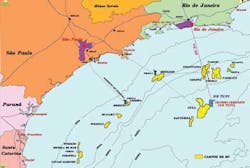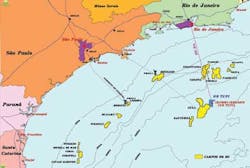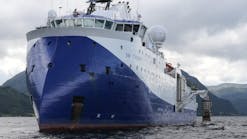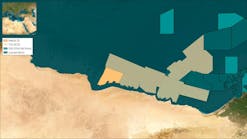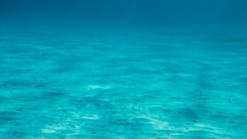Discussion of offshore exploration and production in Latin America has to begin with Brazil, where state oil company Petrobras and a growing number of foreign oil companies continue to score drilling successes on a regular basis.
For Petróleo Brasileiro S.A. (Petrobras), the year 2011 became the latest in a series of record achievements:
- In Brazil, proved reserves reached 15.71 Bboe based on the Brazilian National Oil, Natural Gas and Biofuels Agency (ANP)/SPE criteria. The Reserve Replacement Index (RRI) was 152%, and the reserve/production ratio stood at 19.2 years. For the 20th consecutive year, Petrobras had an RRI above 100%
- For Petrobras, oil and natural gas output averaged a daily record of 2,622,000 boe. In Brazil only, the average oil and natural gas liquids (NGL) output was 2,022,000 b/d, 1% more than the 2010 average
- Output surged in the presalt in 2011: the daily average rose to 201,000 boe in December, up from 103,000 boe in January of last year
- The Guará area (currently the Sapinhoá field) was declared commercial in December, with a total recoverable volume estimated at 2.1 Bboe
- Five new production systems and 11 offshore drilling rigs came into operation (three more were undergoing acceptance tests at the end of the year)
- Oil product sales on the Brazilian market were up by 9% over 2010, closing the year at 2,131,000 b/d.
All indicators suggest that the aggressive exploration off Brazil will continue. A recent study by energy analysts Infield Systems estimates that "Brazilian giant Petrobras is expected to continue its dominance of the deepwater sector with its projected share of expenditure to 2016 forecast to reach 26% of the total global capex expenditure. The operator's deepwater spend will predominately center upon presalt assets within the Santos basin."
From a regional perspective, Infield says, the share of reserves coming onstream is expected to be highest from the Latin American region – forecast to be 39% of total global reserve additions during the 2012 to 2016 period, with more than 60% of such reserves anticipated to be located in Brazil's presalt basins.
Infield Systems expects the largest proportion of deepwater investment to be directed toward pipeline installations; comprising 39% of total global deepwater expenditure. Latin America and Africa are expected to account for the greatest proportion of deepwater pipeline spend.
Infield's spending forecasts are included in eighth edition of the "Global Perspectives Deep and Ultra-deepwater Market Report," which provides an analysis of the key regions for deepwater development and growth over the period 2007 to 2016. The forecast focuses on capital expenditure on platforms, subsea, pipelines, and control lines at water depths of 500 m (1,640 m) and greater.
In other developments, the second well drilled after the execution of the transfer of rights agreement with ANP by Petrobras in the Santos basin presalt Tupi Northeast discovered oil.
Well 1-BRSA-976-RJS (1-RJS-691), is northeast of the Lula field, in water depth of 2,131 m (6,691 ft), and 255 km (158 mi) off the coast of the city of Rio de Janeiro.
The discovery produced 26º API oil by wireline testing from a well depth of 4,960 m (16,273 ft). It has identified so far an oil column in the presalt carbonate reservoirs of more than 290 m (951 ft) thickness.
The well has been cased in the reservoirs intervals and continues to drill to investigate the final depth of such reservoirs, as well as to verify the oil/water contact. Upon completion of drilling, an extended well test is planned.
The transfer of rights agreement with the ANP establishes a volume of hydrocarbons that Petrobras can produce from the area and a price it will pay for that production.
Previously, Petrobras discovered light oil and gas accumulation in the Tambuata prospect, also in the Espirito Santo basin.
Well 4-GLF-31-ESS was drilled in 1,520 m (4,987 ft) water depth in the Golfinho Concession (4-BRSA-1001-ESS). The location is 74 km (46 mi) offshore and 7 km (4.35 mi) from the FPSOCidade de Vitória on the eastern side of the Golfinho field.
Drilling will continue to a planned depth of 6,100 m (20,000 ft) to test deeper formations. Cretaceous period, Santonian-age reservoirs have been identified at a depth between 4,530 and 4,670 m (14,862-15,321 ft), with good conditions for production.
The well is part of Petrobras' Varredura project, designed to boost the production of hydrocarbons in new finds close to existing offshore production systems.
Petrobras' well 4-BRSA-946C-SPS, informally referred to as Biguá, also found a new accumulation of good-quality oil in the Santos basin presalt play.
The well, in block BM-S-8, is 270 km (168 mi) offshore São Paulo state in the 1-BRSA-532A-SPS Discovery Appraisal Area in 2,180 m (7,152 ft) water depth.
A third well is scheduled to spud in the Carcará area in a few days, says Petrobras.
Petrobras is the consortium operator (66%) in partnership with Shell Brasil Petroleo Ltda (20%) and Petrogal Brasil (14%). Shell's interest was acquired by Barra Energia do Brasil Petróleo e Gás Ltda (10%) and Queiroz Galvão Exploração e Produçáo S.A. (10%) subject to final approval by ANP.
Petrobras recently announced the start up of FPSOBW Cidade de São Vicente in the Iracema area (block BM-S-11), in the presalt layer of the Santos basin. The platform was connected to well RJS-647, at a water depth of 2,212 m (7,257 ft).
The platform will operate in the area for approximately six months, with the goal of gathering technical data on the behavior of the reservoirs and the oil flow in the subsea lines, along with other data. The information gathered will support the development of the final production system, expected to start operations in the area at the end of 2014 with the installation of FPSOCidade de Mangaratiba.
During the test period, the well is expected to produce at a restricted flow of approximately 10,000 b/d of oil. The project is being developed by the consortium formed by Petrobras (the operator, with a stake of 65%), BG E&P Brasil Ltda. - BG Group (25%) and Petrogal Brasil S.A. (10%).
The most recent Santos basin discovery, made by Repsol-Sinopec Brasil, is the Pão de Açúcar well in block BM-C-33 in 2,800 m (9,186 ft) of water. It has an indicated production of 5,000 b/d of oil and 807,000 cm/d (28.5 MMcf/d) of gas.
The well found a total hydrocarbon column 480 m (1,575 ft) thick, with approximately 350 m (1,148 ft) of that hydrocarbon-bearing. The formation test, performed on a partial section of one of the reservoirs of roughly 220 m (722 ft).
Repsol-Sinopec Brasil is the operator with a 35% stake, in partnership with Statoil (35%) and Petrobras (30%). The consortium plans additional analyses to confirm the extension and volume of the discovery.
Late last year, Petrobras confirmed the presence of oil and gas accumulations in ultra-deepwater of the Sergipe-Alagoas basin, after completing a lined well formation test in the BM-SEAL-11 concession in block SEAL-M-426. This is the first exploratory project in ultra-deepwater on the Sergipe state side of the basin.
The 1-BRSA-851-SES (1-SES-158) well, known as "Barra," is located at a water depth of 2,341 m (7,680 ft). Barra is 58 km (36 mi) off the Sergipe coastline and 90 km (56 mi) from the city of Aracaju. Information obtained to date is sufficient to confirm the discovery of a new oil province in the Sergipe-Alagoas basin.
The discovery was confirmed by wireline logging and fluid sampling during the lined well formation test. Permeability and porosity conditions were found to be excellent in the reservoirs located at depths of around 5,050-5,400 m (16,570-17,720 ft). The oil sample was of excellent quality, with API around 43° in the upper interval and 32° in the lower interval.
Exploration of the SEAL-M-426 block by the Petrobras (60%) and IBV-Brasil (40%) consortium will continue.
Meanwhile, OGX Petróleo e Gás has announced first oil with the beginning of the extended well test (EWT) in the Waimea accumulation. Following the injection of chemical fluids in well OGX-26HP on Jan. 28, the well was opened for production on Jan. 31.
Over the coming weeks, OGX will test different flow rate levels, gradually reaching a stable production level of around 15,000 b/d. OGX expects to declare commerciality for Waimea after gathering conclusive reservoir data, which is expected during the first half of 2012.
After that, the company anticipates connecting two additional horizontal wells, which could take production levels to 40,000 – 50,000 b/d during the second half of the year.
OGX also has confirmed presalt microbiolite reservoirs with hydrocarbons in the shallow waters of the Santos basin. The wildcat well 1-OGX-63-SPS, in BM-S-57, identified hydrocarbon both in the Aptian and Albian sections. OGX holds a 100% working interest in this block.
The OGX-63 well identified a hydrocarbon column of approximately 1,000 m (3,281 ft) with a net pay of 110 m (361 ft) in the Albian section. The drilling reached the Aptian section, where it identified hydrocarbons through a high gas presence that resulted in a "kick" that OGX takes as indicating favorable permo-porosity characteristics and high pressure.
The kick was controlled and the analysis of rock fragments confirmed a microbiolite reservoir of Aptian age – the same type of reservoir rock found in the deep and ultra-deepwater presalt of the Santos and Campos basins.
Due to the high pressures, drilling was suspended to replace theOcean Quest rig with the Ocean Star. The Ocean Star is equipped to continue the operation, which is expected to include logging and possibly conducting at least one drillstem test.
The OGX-63 well, known as "Fortaleza," is in the BM-S-57 block 102 km (63 mi) off the coast of the state of Rio de Janeiro at a water depth of approximately 155 m (509 ft).
An extended well test by BG Group at the Carioca well offshore Brazil has increased the potential production from the Santos basin discovery.
BG says the test at 3-SPS-74 (Carioca Nordeste) indicated potential production of 28,000 b/d of oil. The well currently is producing 23,400 b/d into the FPSODynamic Producer.
Area potential was strengthened with the results of well 4-BRSA-973A-SPS (Abaré) 35 km (22 mi) south of the initial Carioca discovery well and 293 km (182 mi) offshore São Paulo state. Here, wireline samples indicated 28° API oil from carbonates at about 4,830 m (15,846 ft). A drillstem test is scheduled.
ANP has approved a revision of activities and has extended the deadline for a declaration of commerciality from November 2011 to December 2013. There is no change to the consortium's plans and schedule for development and production.
BG Group has a 30% interest in block BM-S-9 which is comprised of two appraisal areas – Guará and Carioca (Petrobras 45%, operator, and Repsol Sinopec 25%).
Guyana
The jackupAtwood Beacon has spudded Repsol's Jaguar-1 on the Georgetown Petroleum Prospecting License offshore Guyana.
According to partner CGX Energy, the well will be drilled to a depth of 6,500 m (21,325 ft) to test the Turonian geologic zone, which has proven to be prolific offshore West Africa and Brazil.
